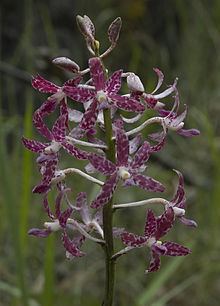Family Orchidaceae Tribe Cymbidieae Rank Species | ||
 | ||
Similar Dipodium, Dipodium punctatum, Cryptostylis erecta, Dipodium roseum, Cryptostylis subulata | ||
Blotched hyacinth orchid dipodium variegatum
Dipodium variegatum, commonly known as blotched hyacinth-orchid or slender hyacinth-orchid, is a leafless mycoheterotrophic orchid that is endemic to south-eastern Australia. It forms mycorrhizal relationships with fungi of the genus Russula.
Contents
- Blotched hyacinth orchid dipodium variegatum
- Description
- Taxonomy
- Distribution and habitat
- Ecology
- Conservation
- Cultivation
- References
Description
For most of the year, plants are dormant and have no above-ground presence. Below the ground lie fleshy roots. Flower spikes between 30 and 60 cm in height appear between August and February. These racemose inflorescences have 2 to 50 cream to light green fleshy flowers with maroon blotches. The sepals and petals are slightly recurved and the three-lobed labellum is maroon or mauve with mauve hairs. A form with tepals and petals that are completely dark maroon is found in Tallebudgera in Queensland.
This species may be distinguished from others in the genus by spots on both the pedicels and ovaries.
Taxonomy
The species was formally described in 1987 by Australian botanists Mark Clements and David Lloyd Jones. The type specimen was collected beside the Pacific Highway in Beenleigh, Queensland.
Distribution and habitat
Dipodium variegatum occurs in the states of Queensland, New South Wales and Victoria.
Ecology
DNA recovered show it forms mycorrhizal associations with Russula solaris and R. occidentalis, in keeping with the observation that many members of the genus form relationships with fungi of the family Russulaceae. The orchid has been observed to occur in close proximity to Eucalyptus species and it is thought that a relationship exists with these trees through this mycorrhizal association.
Pollination of this species, as for all species in the genus, is by native bees and wasps.
Conservation
The species is listed as "rare" on the Victorian Department of Environment and Primary Industries' advisory list of rare or threatened plants in Victoria
Cultivation
No leafless species of Dipodium has been sustained in cultivation due to the inability to replicate its association with mycorrhizal fungi in a horticultural context..
